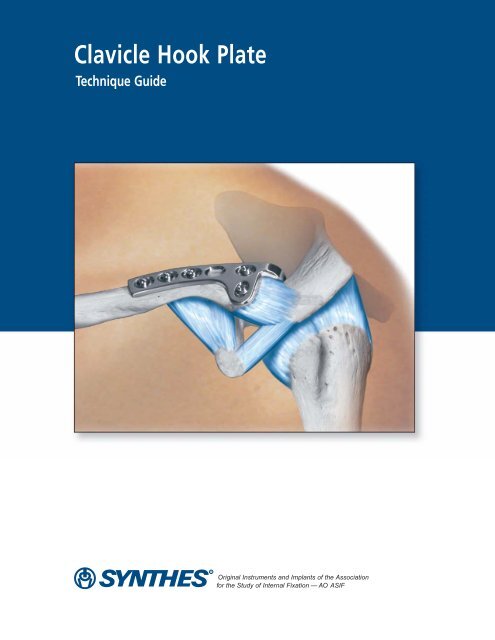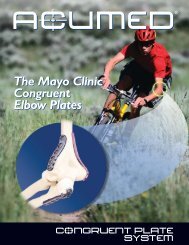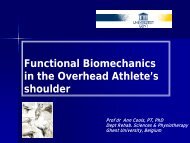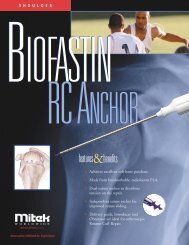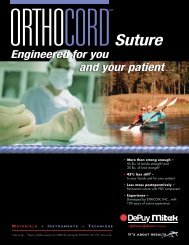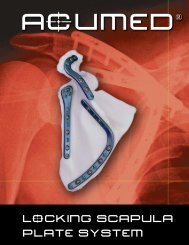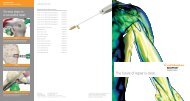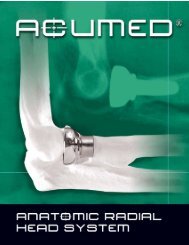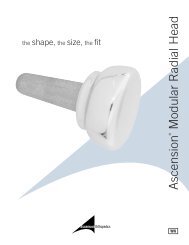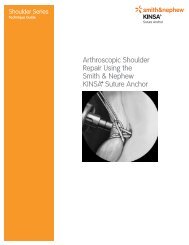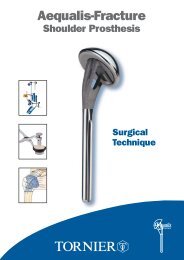Clavicle Hook Plate Technique Guide - ShoulderDoc.co.uk
Clavicle Hook Plate Technique Guide - ShoulderDoc.co.uk
Clavicle Hook Plate Technique Guide - ShoulderDoc.co.uk
Create successful ePaper yourself
Turn your PDF publications into a flip-book with our unique Google optimized e-Paper software.
<strong>Clavicle</strong> <strong>Hook</strong> <strong>Plate</strong><br />
<strong>Technique</strong> <strong>Guide</strong><br />
Original Instruments and Implants of the Association<br />
for the Study of Internal Fixation — AO/ASIF
Overview<br />
The <strong>Clavicle</strong> <strong>Hook</strong> <strong>Plate</strong> provides a single solution for<br />
fixation of both lateral clavicle fractures and<br />
acromioclavicular joint injuries. This plate and screw<br />
<strong>co</strong>nstruct allows early rotational mobility of the shoulder.<br />
Indications<br />
The <strong>Clavicle</strong> <strong>Hook</strong> <strong>Plate</strong> is<br />
indicated for:<br />
• Lateral clavicle fractures<br />
• Dislocations of the<br />
acromioclavicular joint<br />
Lateral clavicle fracture<br />
Dislocation of the acromioclavicular joint
<strong>Clavicle</strong> <strong>Hook</strong> <strong>Plate</strong>s<br />
Features<br />
• Dynamic <strong>co</strong>mpression screw holes accept<br />
3.5 mm <strong>co</strong>rtex and 4.0 mm cancellous<br />
bone screws<br />
• Compatible with the 3.5 mm DCP ® Drill <strong>Guide</strong><br />
[322.32] or the 3.5 mm Universal Drill <strong>Guide</strong><br />
[323.36]<br />
• Anterolateral screw hole provides additional options<br />
for screw fixation in the lateral clavicle<br />
• <strong>Hook</strong> provides additional support to both lateral<br />
clavicle fractures and acromioclavicular<br />
joint dislocations<br />
• <strong>Plate</strong>s available with 6 or 8 holes<br />
• 15 mm and 18 mm hook depths<br />
ac<strong>co</strong>mmodate patient anatomy<br />
• Pre<strong>co</strong>ntoured in left and right plates<br />
• Available in <strong>co</strong>mmercially pure (CP) titanium or<br />
316L stainless steel<br />
• Offset hook design to avoid insertion of<br />
hook into acromioclavicular ligament<br />
441.067<br />
241.064<br />
1
Surgical <strong>Technique</strong><br />
Lateral <strong>Clavicle</strong> Fractures<br />
1<br />
Incision<br />
Through a standard surgical incision, taking care<br />
not to disrupt the surrounding soft tissues, expose<br />
the outermost part of the clavicle, the fracture site,<br />
and the acromioclavicular joint.<br />
2<br />
Insertion<br />
Perform temporary fixation of the fracture using<br />
Kirschner wires or bone holding forceps. Dissect<br />
the soft tissue, posterior to the acromioclavicular<br />
joint, to prepare a path for the insertion of the<br />
hook. Using the plate with 15 mm hook depth, pass<br />
the hook under the acromion. Place the shaft of the<br />
plate onto the superior aspect of the clavicle. If<br />
there is difficulty lowering the plate shaft onto the<br />
clavicle, then the plate with 18 mm hook depth<br />
should be used. Once the plate shaft is placed on<br />
the clavicle, the end of the hook should be in<br />
<strong>co</strong>ntact with the underside of the acromion.<br />
Confirm that the <strong>co</strong>rrect anatomic alignment of the<br />
clavicle and acromion has been restored without<br />
impingement of the rotator cuff. Also before<br />
fixation, use the c-arm to verify that full shoulder<br />
motion, particularly in abduction and external<br />
rotation, can be achieved without impingement of<br />
the humeral head on the hook.<br />
3<br />
Fixation<br />
One or two screws (either 3.5 mm <strong>co</strong>rtex or<br />
4.0 mm cancellous bone screws) can be placed in<br />
the lateral plate holes. The position and angulation<br />
of the screws depends on the fracture <strong>co</strong>nfiguration.<br />
The 3.5 mm <strong>co</strong>rtex screws placed in the medial<br />
plate holes can be positioned eccentrically<br />
depending on the fracture <strong>co</strong>nfiguration, to provide<br />
dynamic <strong>co</strong>mpression of the fracture fragments.<br />
2
Dislocation of the Acromioclavicular Joint<br />
1<br />
Incision<br />
Through a standard surgical incision, taking care<br />
not to disrupt the soft tissues, expose the acromioclavicular<br />
joint and the lateral shaft of the clavicle.<br />
2<br />
Insertion<br />
Push down on the clavicle to reduce the dislocation<br />
of the acromioclavicular joint and provide<br />
temporary fixation using Kirschner wires. Dissect<br />
the soft tissue, posterior to the acromioclavicular<br />
joint, to prepare a path for the insertion of the<br />
hook. Perform any ligament or capsule repairs.<br />
Using the plate with 15 mm hook depth, pass the<br />
hook under the acromion. Place the plate on the<br />
superior aspect of the clavicle and <strong>co</strong>nfirm that the<br />
<strong>co</strong>rrect anatomic alignment of the clavicle and<br />
acromion has been restored. If the realignment<br />
appears to be over<strong>co</strong>rrected, use the plate with<br />
18 mm hook depth. Before fixation use the c-arm<br />
to verify that full shoulder motion, particularly in<br />
abduction and external rotation, can be achieved<br />
without impingement of the humeral head on<br />
the hook.<br />
3<br />
Fixation<br />
If sutures are used to repair the ligaments, the<br />
sutures can be passed through the lateral hole(s)<br />
of the plate and tied under tension to provide<br />
additional stability to the acromioclavicular joint.<br />
Place 3.5 mm <strong>co</strong>rtex or 4.0 mm cancellous bone<br />
screws in the medial plate holes. Tighten the<br />
screws, ensuring that the acromioclavicular joint is<br />
reduced and stable.<br />
3
Removal of the Implant<br />
Caution<br />
It is re<strong>co</strong>mmended that the <strong>Clavicle</strong> <strong>Hook</strong> <strong>Plate</strong> be<br />
removed after healing to prevent potential irritation<br />
of the acromion or impingement of the rotator cuff.<br />
3.5 mm <strong>Clavicle</strong> <strong>Hook</strong> <strong>Plate</strong>s<br />
241.064<br />
RIGHT LEFT HOLES HOOK DEPTH MATERIAL<br />
241.062 241.063 6 15 mm Stainless Steel<br />
241.064 241.065 6 18 mm Stainless Steel<br />
241.066 241.067 8 15 mm Stainless Steel<br />
241.068 241.069 8 18 mm Stainless Steel<br />
441.067<br />
RIGHT LEFT HOLES HOOK DEPTH MATERIAL<br />
441.062 441.063 6 15 mm Titanium<br />
441.064 441.065 6 18 mm Titanium<br />
441.066 441.067 8 15 mm Titanium<br />
441.068 441.069 8 18 mm Titanium<br />
4
SYNTHES (USA)<br />
1690 Russell Road,<br />
Paoli, PA 19301-1262<br />
Telephone: (610) 647-9700<br />
Fax: (610) 251-9056<br />
To Order: (800) 523-0322<br />
SYNTHES (CANADA) LTD.<br />
2566 Meadowpine Boulevard<br />
Mississauga, Ontario L5N 6P9<br />
Telephone: (905) 567-0440<br />
Fax: (905) 567-3185<br />
To Order: (800) 668-1119<br />
© 2003 SYNTHES (USA) DCP, SYNTHES and ASIF are registered trademarks of SYNTHES (USA) and SYNTHES AG Chur. Printed in U.S.A. 10/03 J4765-A


